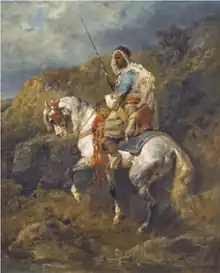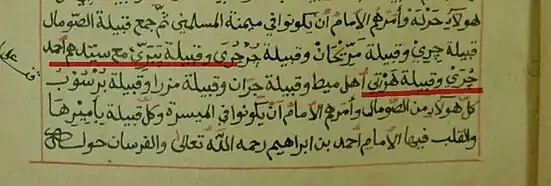Commander of the Somali Adalite Division Ahmed Girri Bin Hussein Al Somali أحمد جرئ بن حسين الصومالي | |
|---|---|
 Chieftain Ahmed Girri Bin Hussein on horseback | |
| Native name | Ahmed Girri Bin Hussein |
| Born | 1500s ( unknown ) |
| Allegiance | Adal Sultanate |
| Service/ | Chieftain of the Habr Maqdi |
| Rank | Division Commander |
| Battles/wars | Battle of Amba Sel |
Ahmed Girri Bin Hussein (Soomali: Axmed Girri Bin Xussein Arabic أحمد جرئ بن حسين الصومالي) was a Somali military commander and Adalite general that served the Adal Sultanate. He was the right-hand man of Imam Ahmed Al-Ghazi and played a very prominent role in the campaigns against the Abyssinians by bringing one of the largest armies to aid the imam in Jihad. Ahmed Girri Bin hussein hailed from the Yabarray clan.[1] He was also the chieftain of Habr Maqdi which was a confederation of Yabarray and Bartirre. He was regarded as one of the most capable generals along with Garaad Matan.[2]
Early life
Born into the prominent Yabarray clan of Jidwaaq a branch of the Darood,[1][3] He played key figure in the Muslim conquests in the Horn of Africa by bringing one of the largest armies in Adal his brother Garaad Dhaweyd was the chieftain leader of Bartirre[4] and was mentioned among the honorable knights with the imam. Ahmed Girri bin Hussein was the chieftain leader of Yabarray, He also led the entirety of the Habr Maqdi.
The clan of Ahmed Girri bin Hussein is confirmed by many scholars to be of Yabarray
Cahiers d'études africaines confirms
la valeur guerrière est restée jusqu'à nos jours une des qualités maîtresses des Somalis; d'autre part on sait que les Somalis, et spécia-lement les Somalis Darod, étaient en pleine expansion vers l'ouest et les Geri, les Marrehân, les Harti qui sont cités ailleurs, et les Yabarray qui s'identifient sans doute avec les Yiberri du Futuh el Habasa ,sont précisément des Darod.L'alliance entre les Musulmans du « Royaume d'Adal » et les Somalis aurait ainsi permis aux premiers d'utiliser la force d'expansion des envahisseurs Darod, pour leur entreprise de conquête de l'Abyssinie. Aux Somalis, il faut ajouter les Harlah qui, sous le nom de Harla se considèrent maintenant comme une fraction des Cisa mais sont nettement distingués des Somalis dans le Futuh[5][1]
English Translation
warrior valor has remained one of the main qualities of the Somalis to this day; on the other hand, we know that the Somalis, and especially the Darod Somalis, were in full expansion towards the west and the Geri, the Marrehân, the Harti who are cited elsewhere, and the Yabarray who undoubtly identify with the Yiberri of Futuh el Habasa are precisely Darod. expansion of the Darod invaders, for their enterprise of conquest of Abyssinia. To the Somalis must be added the Harla who, under the name of Harla now consider themselves a fraction of Issa but are clearly distinguished from the Somalis in the Futuh[5][1]
Arab Faqih notes
Then he assembled the Somali clans the tribe of Girri, the tribe of Marraihan, the tribe of Yibberi with their chieftain Ahmad Girri, the clan of the Härti, people of Mait, the tribe of Jairan, the tribe of Mazzar. the tribe of Barsub all of these were Somalis and they were ordered by the imam to hold the left they were all under Matan [6]

The famous Futuh Al Habesh manuscript written during the 16th century by Shihāb al-Dīn Aḥmad ibn ʻAbd al-Qādir ʻArabfaqīh, who was present during the rise and fall of Adal Sultanate and also during the jihad. Sihab ad din would later document the Ethiopian-Adal war, Sihab documented the Somali clans that participated in the Ethiopian-Adal war. It translates to The tribe of Yabarray came with their chieftain and leader Ahmed Girri[9][10]
Military campaigns
It is noted that Ahmad Girri bin Hussain was one of the most capable Adalite generals along with Garaad Matan the Somali. Ahmed Girri Bin Hussein was the chieftain of Yabarray clan but also led the Habar Maqdi which was a confederacy between Bartirre and Yabarray. Both are part of the Jidwaaq clan today which is part of the larger Darood Clan. But most times he led Yabarray and Bartirre under Habar Maqdi.
Arab Faqih confirms that Habar Maqdi is Bartirre,
Then he split his force into three divisions. The first consisted of the people of Sim, the tribe of Marraihan and Bar Tarri which are the Habr Magdi and the people of Jawatir: they were under the command of the wazir 'Addol[4]
Imam's Call To Jihad
The Imam first conquers the Habar Maqdi for engaging in banditry subsequently making them submit afterwards the Habar maqdi tribe then made peace with Imam Ahmed. Before the Conquest of Abyssinia Imam Ahmed al Ghazi began sending messengers to every tribe in the vicinity of Harar and its surrounding areas. The first tribe to accept jihad was the Habar Maqdi clan with their leader Ahmed Girri bin Hussein, they brought the largest army numbering 2000 soldiers consisting a confederacy of Yabarray and Bartirre.
Arab faqih notes
The storyteller says: At that time the imam organised his forces and called up his army. He tied a white standard to a spear, and entrusted it to wazir 'Addoli and the people of Sim rallied to him from the tribe of the Somalis the Habr Maqdi and the tribe of Ahmad Girri, and with them two-hundred cavalry and two thousand infantry like savage lions[11]
Arab Faqih also notes how the imam was extremely elated at the fact that the Habar Maqdi clan accepted the call to Jihad. The Habr Maqdi clan was the first tribes to accept jihad along with the Geri clan under Garad Matan, Its also documented that they encamped in Qasa a place near Harar.
Arab Faqih details
The first of the tribes to arrive to the mam was Habr Maqdi with their leader and chieftain Ahmad Girri bin Husain, the Somali. They encamped in a place called Qasa in the heights above the valley of Harar. They showed off their equipment and their weapons, and paraded their horses. They were knights, and what knights! And they were great foot-soldiers; and what foot soldiers! The imam rejoiced at their arrival exceedingly. They met the imam face to face, and he welcomed them with the warmest of welcomes. He gave them gifts of apparel, and provisions, and treated them graciously, garbing their chieftain Ahmad Girri in particularly exquisite clothing[12]
See also
References
- 1 2 3 4 "Cahiers d'études africaines". Cahiers d'études africaines. 2: 30. 1961 – via Google books.
- ↑ Arabfaqih, Shihab Al-Din (2003). The Conquest of Abyssinia: Futuh Al Habasa. Tsehai Publishers & Distributors. p. 76. ISBN 0972317260.
- ↑ Paul lester, Stenhouse (2003). Futuh Al Habesh. Tsehai Publishers & Distributors. p. 76. ISBN 0972317260.
- 1 2 al-Dīn, Shihāb (2003). The Conquest of Abyssinia. Tsehai Publishers & Distributors. p. 125. ISBN 0972317260.
- 1 2 Ferry, Robert (1961). "Quelques hypothèses sur les origines des conquêtes musulmanes en Abyssinie au XVIe siècle". Cahiers d'Études africaines. 2 (5): 30. doi:10.3406/cea.1961.2961.
- ↑ Arabfaqih, Shihab Al-Din (2003). The Conquest of Abyssinia: Futuh Al Habasa. Tsehai Publishers & Distributors. p. 76. ISBN 0972317260.
- ↑ Ad-Din, Shihab. Futuh Al Habesh بهجة الزمان (in Arabic). makhtota.ksu.edu.com. p. 36.
- ↑ ʿArabfaqīh, Šihāb ad-Dīn Aḥmad Ibn ʿAbd al-Qādir; Stenhouse, Paul Lester; Pankhurst, Richard; ʿArabfaqīh, Šihāb ad-Dīn Aḥmad Ibn ʿAbd al-Qādir (2003). Futūḥ Al-Ḥabaša: the conquest of Abyssinia (16th century). Tsehai. p. 76. ISBN 978-0-9723172-6-9.
- ↑ Abdullahi Diriye, Mohamed (2001). Culture and Customs of Somalia (Culture and Customs of Africa). Canada: Bloomsbury Academic. p. 17. ISBN 9780313313332.
- ↑ The Ethiopian Borderlands. Red Sea Press. 1997. p. 165. ISBN 9780932415196.
- ↑ al Din, Sihab (2003). Futuh al habesh. Tsehai Publishers & Distributors. pp. Page=49. ISBN 9780972317252.
- ↑ Adin, Sihab (2003). The Conquest of Abyssinia. Tsehai Publishers & Distributors. p. 43. ISBN 9780972317269.